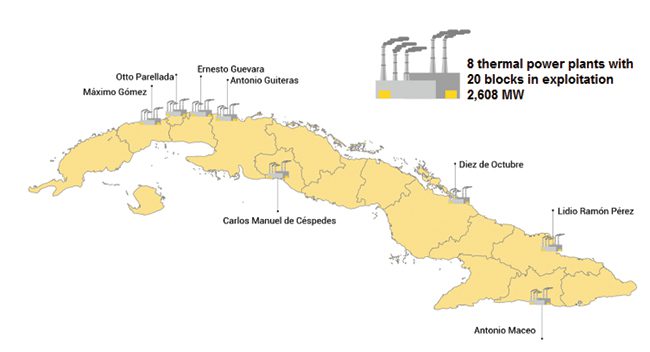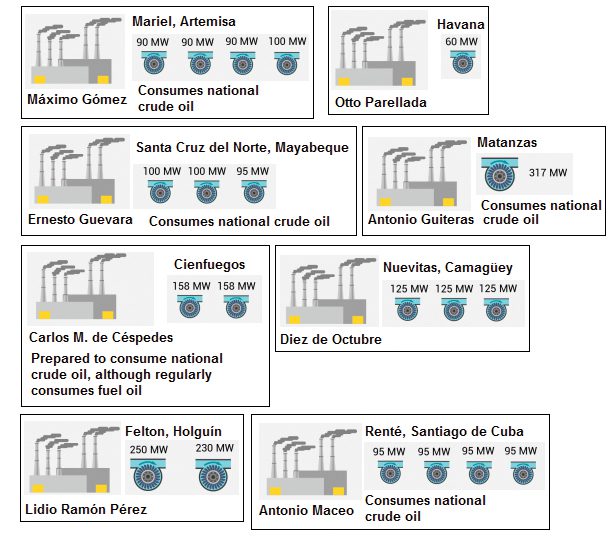Thermal Power Plants in Cuba Struggle to Meet Demand
Since 2021, Cuba has been going through a complex situation in its national electrical system. Blackouts have been increasing, with higher incidents in recent months. Although projections predicted an improvement in these conditions for the summer season, lessening the annoying blackouts, several accidents in generating units, together with the technological obsolescence of most of the plants, have caused the energy deficit to persist over time, causing discomfort in the population and significant negative effects on the economy.
Cuba depends to a large extent on fossil fuels for the production of electricity, being responsible for 95% of what is consumed today. According to data provided by the Ministry of Energy and Mines, the country’s installed power generation capacity exceeds 6 GW if all forms of generation are considered. Of these, almost 2.6 GW depend on thermal power plants, which constitute the base generation and are the most robust system.
About 40.6% of Cuba’s power generation is produced in thermal power plants, 21.7% with fuel oil engines, and 21.9% with diesel engines. These last two technologies in the distributed generation facilities installed throughout all the provinces of the country. Today, almost 8% is produced with the accompanying gas from oil production, 5% comes from renewable energy sources (hydro, solar, and wind), and the remaining 3% is produced by floating units (thermal power barges). As has been mentioned, in recent months, the system has operated with a generation deficit—without reserves—which is why the blackouts happen. In the case of the Cuban electrical system, the required reserve target is equal to (or greater than) 500 MW in order to supply any unexpected contingency or for maintenance needs of high-power generating units.
There are eight thermoelectric plants in the country with a total of 20 blocks in operation, which constitute the most important part of the base generation of the electrical system. Of the total block, only 16 are available.
The useful life of a thermoelectric plant is between 30 and 35 years. However, the weak spot of thermal generation in the country is its ageing. Except for the two Felton blocks, which have been synchronized for 25 and 21 years, respectively, the others have all been in operation for more than 30 years, and seven blocks have been operating for more than 40 years.
 |
|
2. Location of thermal power plants in Cuba. Courtesy: Ministry of Energy and Mines |
Edier Guzmán Pacheco, director of thermal generation for the state-owned Unión Eléctrica, has detailed that the installed power in the thermal blocks is 2,608 MW, distributed in eight thermoelectric plants (Figure 2). In total, there are 20 generation blocks of various technologies or manufacturers, including the new Mariel block. They are divided into 10 blocks from the former Soviet Union; two Japanese blocks—Hitachi brand; six blocks from the former Czechoslovakia; and one French block, from Alstom, at the Antonio Guiteras thermal power plant. Now, Mariel Block 6 has been added, whose boiler was built in Slovakia and the turbine is of Russian origin.
The Cuban thermal power plants (TPP) are the following:
- ■ The Máximo Gómez TPP, located in Mariel province of Artemisa, currently has three units of 90 MW each with technology from the former Soviet Union. The newest unit (Unit 6) has a 100-MW capacity. This plant has the possibility of consuming national crude oil that contributes to its energy independence.
- ■ The Otto Parellada TPP, located in the capital of the country (Havana), has an installed capacity of 60 MW with technology from the former Czechoslovakia, which has the benefit of being close to the consumption points, which contributes to the reduction of electrical losses.
- ■ The Ernesto Guevara TPP, in the municipality of Santa Cruz del Norte in the province of Mayabeque, has three units—two of 100 MW and one of 95 MW—one of Soviet technology that can also consume national crude fuel with the advantage that it has the supply through pipeline, which reduces fuel transportation costs.
- ■ Antonio Guiteras TPP, in the province of Matanzas, has the largest generating unit in the country with a capacity of 317 MW of French technology. This block consumes national crude oil that is received by pipeline, and is the most efficient thermal plant in the country.
- ■ The Carlos Manuel de Céspedes TPP, in the province of Cienfuegos, with two Japanese units of 158 MW each, are the most reliable and can receive fuel by pipeline from the Cienfuegos refinery. They are prepared for burning national crude oil, although the plant regularly consumes fuel oil.
- ■ The Diez de Octubre TPP, in the municipality of Nuevitas in the province of Camagüey, with three units of 125 MW of power each and technology manufactured in the former Czechoslovakia.
- ■ The Lidio Ramón Pérez TPP, in Felton in the province of Holguín, with two units—one of 250 MW and another of 230 MW of power—each one with technology from the former Czechoslovakia.
- ■ Antonio Maceo TPP, on the Renté peninsula in Santiago de Cuba, has four units of 95 MW of capacity, each with technology from the former Soviet Union. These blocks also consume national crude oil.
 |
|
3. Thermal power plants and generating blocks in Cuba. Courtesy: Ministry of Energy and Mines |
The useful life of these facilities (Figure 3) depends to a large extent on compliance with maintenance cycles and technical rigor during their execution. “This work is done considering the criteria of the manufacturers, international practices, and the experiences of our engineers. From the use of Cuban crude oil, with sulfur content between 7% and 8%, the maintenance cycles must be shortened, therefore, although the design allowed more time between each of the stops, now they are more frequent due to the aggressiveness of sulfuric acid and the high corrosion inside the boilers. A normal percentage of sulfur in crude oil is at levels of 1.5% or 1.2%, and when it has 3% it is already considered a highly sulfurous percentage, with special treatments that require additives and an initial preparation that includes raising the temperature and treatment of the gases. It is very aggressive, especially for the boilers,” Guzmán explained.
Normally, the maintenance that must be carried out is 20%, which is in the order of 50 to 70 days annually in several planned stops for each block. These maintenances of different types are scheduled between two to three of the light type, of 10 days each, and one of the partial or partial extended type, of 20 to 30 days. Meanwhile, capital maintenance is scheduled every five years. As previously alluded to, of the 20 generating blocks or units, only 16 are available, which is due to the following events:
- ■ A fire that occurred on March 7, 2022, in Unit 7 of the Mariel thermoelectric plant caused the loss of that block and Unit 6. This last block, new, had been synchronized in September 2021 and was in a testing process. In total, 170 MW of power were affected.
- ■ On July 8, 2022, another boiler fire occurred in Felton Block 2, resulting in the loss of a block that had just completed extended partial maintenance. A stable contribution of 230 MW was estimated as part of the summer insurance.
- ■ Block 4 of the Diez de Octubre TPP in Nuevitas was paralyzed due to a high degree of deterioration in the boiler after more than 10 years without carrying out capital maintenance, which is scheduled every five years, due to lack of resources. That affected about 70 MW.
In this scenario, the power of these four blocks must be subtracted from the 2,608 MW installed in thermal generation: 565 MW of installed power and about 460 MW of real power.
In order to reverse the complex situation that the Cuban electric power industry is going through and put an end to the annoying blackouts, the designed strategy was recently updated, maintaining the objective of recovering generation capacities, backed by funding assigned for the execution of this gradual recovery program that allows reaching sustainability and affordability. The gradual strategy intends that, before the end of 2023, the sector recovers 489 MW of power, which is not available today, of which 291 MW are due to technological limitations in thermal power plants and 198 MW in distributed generation. It was also informed that other projections are to incorporate, by the end of 2023, and with other investments, 531 MW of capacity, complemented by a program to reinforce the contingency plan aimed at reducing the demand and consumption of electricity while the emergency situation lasts. At the same time, it is necessary to speed up the use of clean energy for the production of electricity, as a key element for changing the country’s energy matrix.
—Amaury Pérez Sánchez ([email protected]) is a chemical engineer based in Cuba with the University of Camagüey.